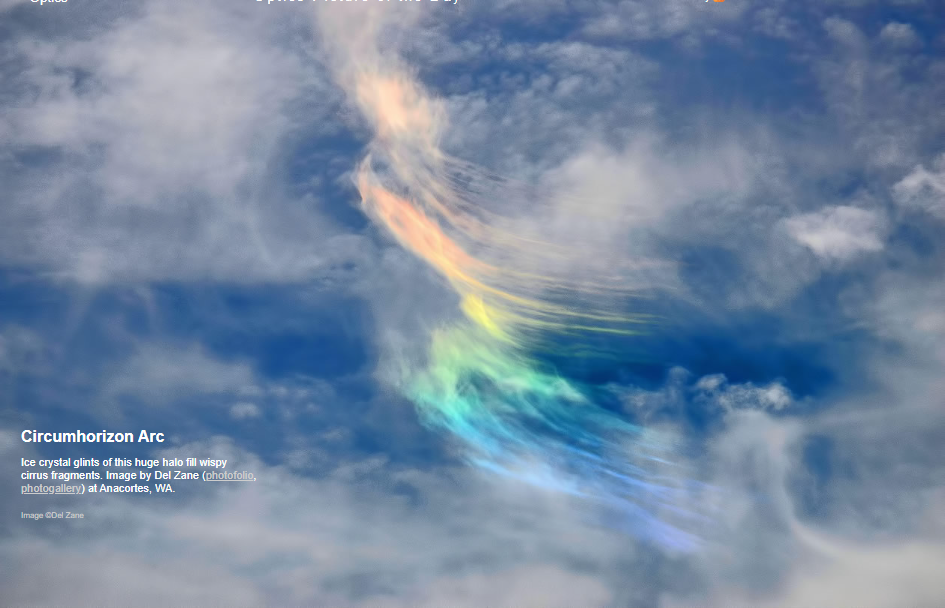OPOD - Circumhorizon Arc
OPOD - Circumhorizon Arc: Exploring the Spectacular Phenomenon
Have you ever gazed at the sky and been captivated by a stunning display of colors? One such mesmerizing spectacle is the Circumhorizon Arc (CHA), a massive and vibrant atmospheric optical phenomenon. Often mistaken for an iridescent cloud, the CHA can be distinguished by its structured colors, with red always appearing at the top. In this article, we will delve deeper into the fascinating world of the CHA, uncovering its formation, rarity, and visibility across different regions.
Formation of the Circumhorizon Arc
The CHA owes its existence to the interaction of sunlight with ice crystals in wispy cirrus clouds. These hexagonal ice crystals act as prisms, causing sunlight to enter through their side faces and exit through their lowest face. This unique process creates a colorful display of light known as the CHA. The formation of this phenomenon is illustrated in the diagram below:

- 'A': A vibrant CHA has formed as sunlight enters and exits the ice crystal.
- 'B': When the sun is lower in the sky, the CHA ray barely manages to escape from the lower face of the ice crystal.
- 'C': As the sun sinks even lower, the ray is entirely internally reflected, resulting in the absence of a CHA.
Rarity and Visibility of the CHA
While the CHA is indeed a breathtaking sight, its extreme rarity is often exaggerated on the internet. In reality, it can be observed several times a year in a single location within the United States. However, due to its dependence on the sun's position, the CHA is more commonly visible during late spring and summer when the sun is higher than 58°.
The visibility of the CHA varies across different regions. Europe, being closer to the pole, experiences fewer occurrences of this phenomenon. The CHA is never seen north of Copenhagen and is rare in the United Kingdom and northern Germany. To explore the visibility charts for the CHA, you can refer to the provided link.
Unveiling the Beauty of the CHA
The sheer size and vibrant colors of the CHA make it a sight to behold. Spanning across the sky, this arc exhibits a wide range of colors, including red, orange, yellow, and green. Its breathtaking display can be attributed to the dispersion of sunlight as it passes through the ice crystals, similar to the formation of a rainbow.
To fully appreciate the CHA, it is crucial to observe it beneath the sun. This positioning ensures that the arc is at its most vibrant and distinct. Keep in mind that the CHA always has red at the top, serving as a distinguishing feature from other optical phenomena.
Capturing the CHA's Beauty
If you're fortunate enough to witness a CHA, consider capturing its magnificence through photography. By using a camera or smartphone, you can immortalize this stunning atmospheric phenomenon. Experiment with different angles and settings to truly capture the essence and grandeur of the CHA.
Conclusion
The Circumhorizon Arc (CHA) is a remarkable atmospheric optical phenomenon that enchants observers with its vast size and vibrant colors. Formed by sunlight interacting with ice crystals in cirrus clouds, the CHA creates a breathtaking display of structured colors. Although not as rare as some may believe, its visibility varies depending on the region and time of year. If you're lucky enough to witness a CHA, take a moment to marvel at its beauty and consider capturing it through photography. The CHA is a testament to the wonders of our atmosphere and serves as a reminder of the hidden marvels that surround us in the sky above.

Circumhorizon Arc
Ice crystal glints of this huge halo fill wispy cirrus fragments. Image by Del Zane (photofolio, photogallery) at Anacortes, WA.
Image ©Del Zane
The circumhorizon arc is huge and very colourful. When seen as a fragment it is oft mistaken for iridescent cloud. To distinguish it, look for structured colours. The CHA is beneath the sun and always has red at top.
It is a late Spring/Summer arc because the sun needs to be higher than 58°. That does not necessarily make it rare. Its extreme rarity is an Internet myth. In any one location in the USA it will be seen several times a year.
However, Europe is much closer t the pole. It is never seen north of Copenhagen and rarely in UK or northern Germany.
Visibility charts here.

CHAs form by sun rays entering the side faces of plate oriented hexagonal ice crystals and leaving through their lowest face. A crystal is shown here as a side cross-section.
In 'A' a colourful CHA has formed. In 'B' the sun is lower and the CHA ray only just manages to escape from the lower face'. In 'C' the sun is lower still and the ray is totally internally reflected rather than leaving to form a CHA.
What of the ray externally reflected going downwards to the right? That contributes to the parhelic circle.
Made using iPad/iPhone App "Prism HD"
Note: this article has been automatically converted from the old site and may not appear as intended. You can find the original article here.
Reference Atmospheric Optics
If you use any of the definitions, information, or data presented on Atmospheric Optics, please copy the link or reference below to properly credit us as the reference source. Thank you!
-
<a href="https://atoptics.co.uk/blog/opod-circumhorizon-arc/">OPOD - Circumhorizon Arc</a>
-
"OPOD - Circumhorizon Arc". Atmospheric Optics. Accessed on November 26, 2024. https://atoptics.co.uk/blog/opod-circumhorizon-arc/.
-
"OPOD - Circumhorizon Arc". Atmospheric Optics, https://atoptics.co.uk/blog/opod-circumhorizon-arc/. Accessed 26 November, 2024
-
OPOD - Circumhorizon Arc. Atmospheric Optics. Retrieved from https://atoptics.co.uk/blog/opod-circumhorizon-arc/.